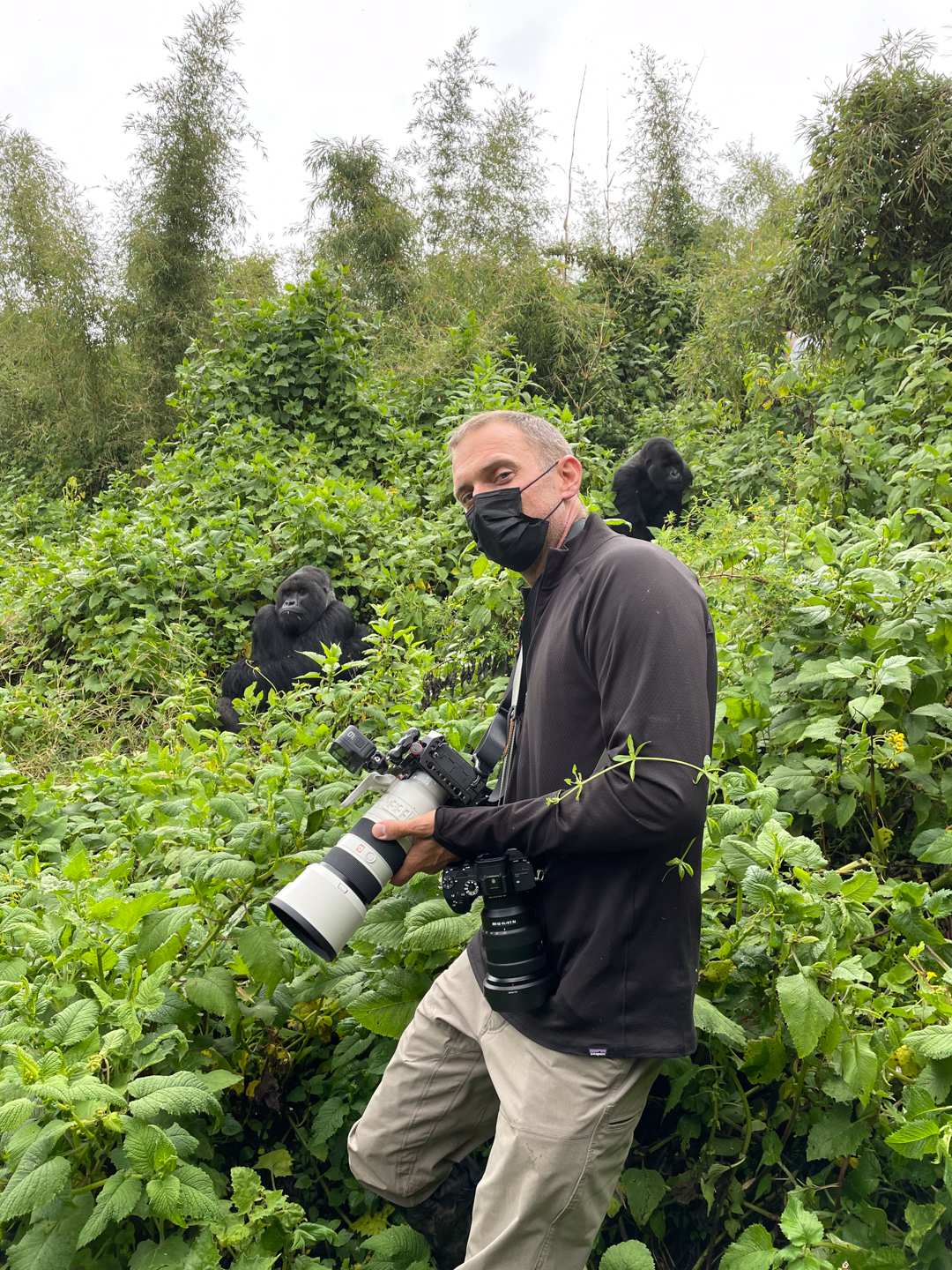by Grahm Jones, Media Productions Coordinator
Partners in Conservation
Learn about the Zoo’s financial commitment to holistic conservation efforts in Central Africa.

by Grahm Jones, Media Productions Coordinator
“Our time is almost up,” our guide quietly informs us.
With the few moments we have left, I give my cameras a rest and try to absorb as much of what is around me and contemplate just how it is that I’m so fortunate to find myself on a mountain in Rwanda, surrounded by gorillas.
As a photographer at the Columbus Zoo and Aquarium, I’m often asked what my favorite animal is. While there’s always something new, exciting, or cute at the Zoo, there’s one species that has always been on the top of my list...
Gorillas.
When I was 10 years old, I visited the Columbus Zoo to see Mac and Mo, the first twin gorillas born in the Western Hemisphere and from that point on, I was hooked. No trip to the Zoo was complete without a visit to the gorilla habitat, where I would sit for hours, marveling at their personalities, ingenuity, and curiosity. These days, I still take every opportunity to visit, only now it's my job to capture imagery of gorillas – and all the other animals and programs at the Zoo – in a way that both engages our guests and supports the Zoo’s mission of empowering people and saving wildlife.
Even during those early visits as a kid, I think I knew that there was no other place I would rather work than the Zoo, which really speaks to the inspirational power the Zoo can have. So, during college, I picked up a seasonal job in the Zoo’s Grounds Department and, 30 years and a few titles later, I’m still here. I guess I was right.
Around the same time that I was beginning my Zoo career, in 1991, a group of dedicated Columbus Zoo employees and volunteers were looking for a way to help gorillas, whose populations were plummeting in their native ranges due to poaching and habitat loss. What started as a rather modest idea has since grown into a longstanding program with an incredible impact on both the wildlife and people of Rwanda—Partners In Conservation (PIC).
This unique program recognizes that to save wildlife, it’s also important to help people coexist with these species. To achieve this, PIC’s work focuses on three key pillars:
Over the years, working alongside the Partners In Conservation team, I’ve had numerous opportunities to hear about their experiences, as well as meet many of the people whose lives have been positively affected during their visits to the U.S. and, specifically, the Columbus Zoo (I highly recommend that you mark your calendar for the Rwandan Fête on September 21, 2024).
Not surprisingly, over time, I found that I had developed a sense of connection to the people and projects that PIC supports, and it became both a professional and personal goal of mine to go to Rwanda someday and see for myself this incredible place I had heard so much about.
In 2022, I received the assignment I had dreamed of...To document the PIC team during their annual trip to Rwanda and – as our Zoo is committed more than ever to expanding our conservation impact – capture their work in a way that illustrates just what it is that makes this program so successful. While I knew this would be no small task, I also knew that it would certainly be a highlight of my career.
After 18 hours on various planes connecting in various countries over the course of various days, I arrived in Kigali, the capital of Rwanda. Meeting up with the PIC team – Jeff Ramsey and Alison Edwards – who had arrived the week prior, we drove south out of Kigali, and I began to absorb the country that I had dreamed of visiting.
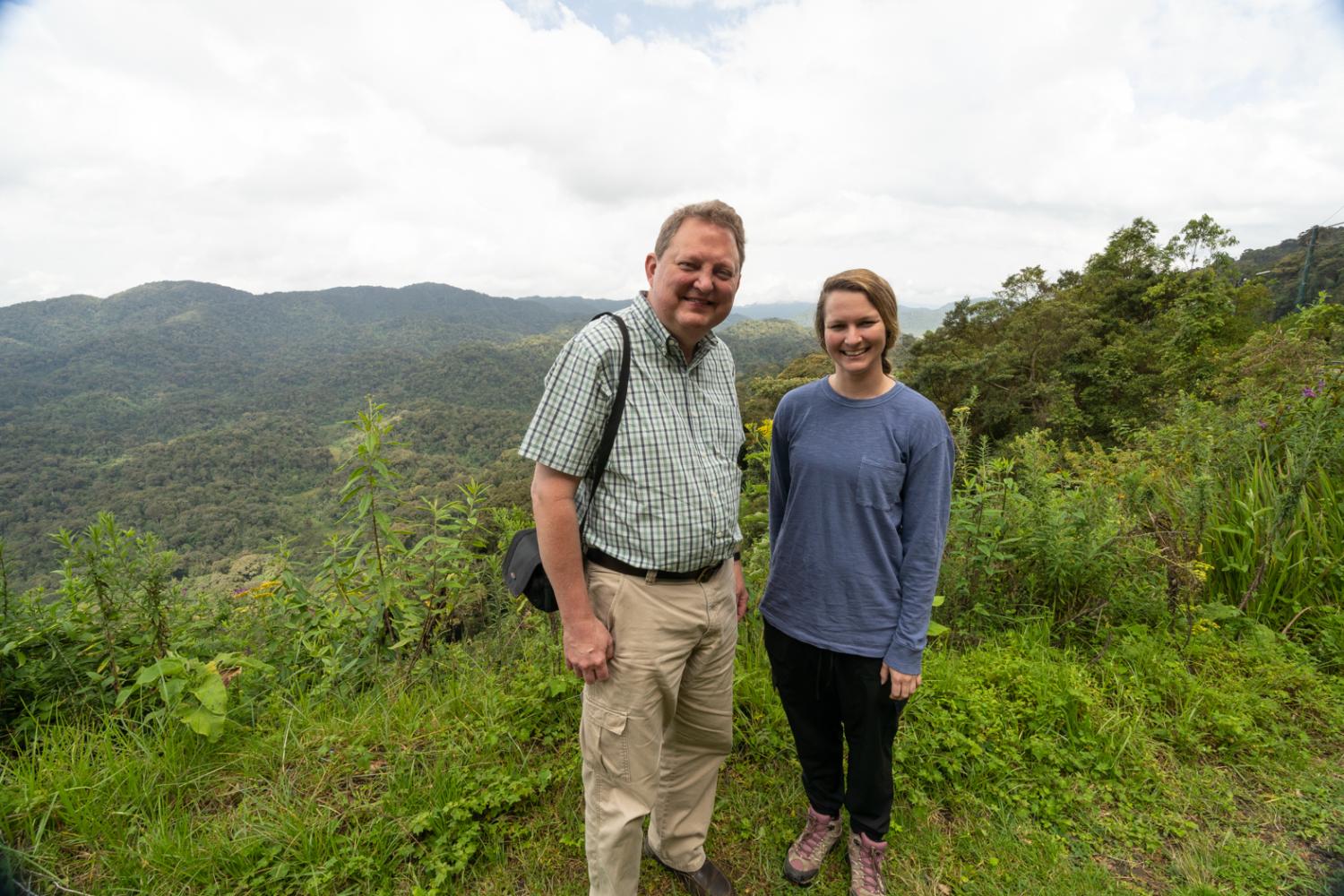
I was immediately struck by the population density and the movement. People were traveling in every direction – on foot, bicycles, motos (mopeds), in cars, trucks, and even hanging off the back of trucks. With everyone competing for the relatively thin stretch of pavement, it looked chaotic and more than a little terrifying. Eventually though, I came to realize that there was some complex order to it. I still closed my eyes a lot, though.

The second thing I was struck by was the color. The buildings, the trees and the clothes all seemed to compete for your attention. The whirlwind of people and cars only intensified the feeling.

And finally, I noticed how modest people's living conditions were. Westerners might be quick to call it poverty, but as meager as people’s possessions and living conditions seemed, I wouldn’t call it poverty. It was different in a way I couldn’t immediately place.
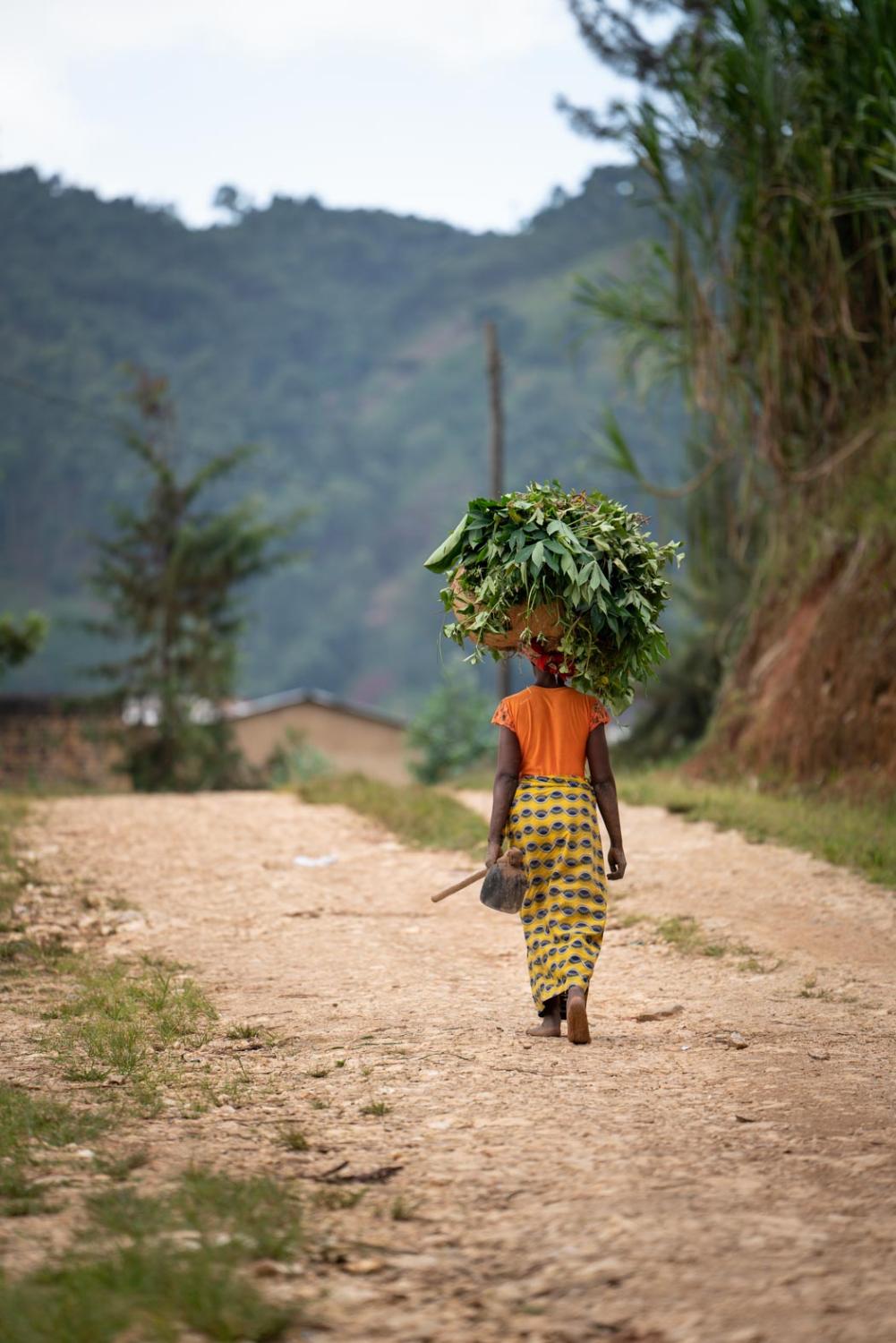
Getting farther away from Kigali, the stunning natural beauty of Rwanda began to show. Tea fields gave way to mountains with more shades of green than you would think is possible. We passed monkeys, duikers, and many species of brightly colored birds as we twisted our way to Nyungwe National Park, which was to be our basecamp for the first half of my trip.
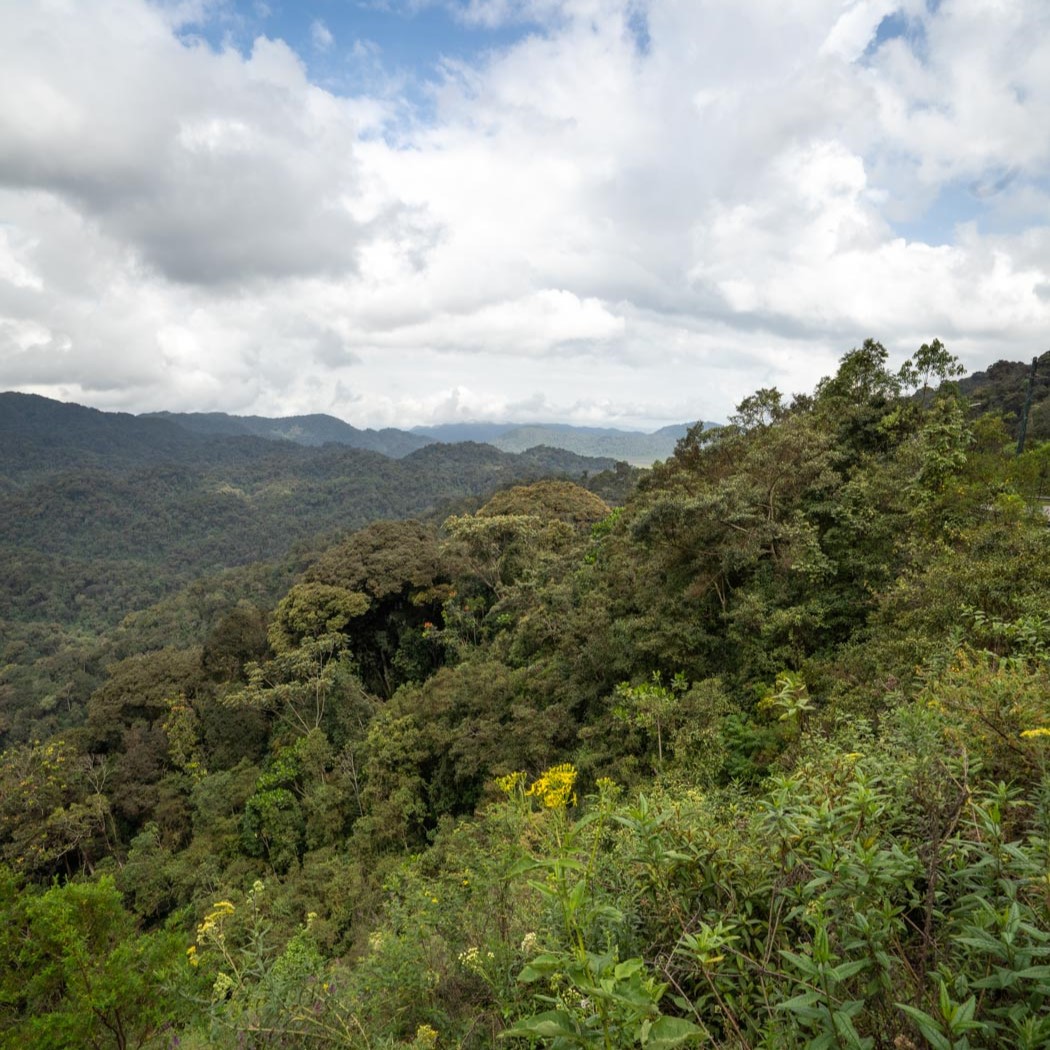
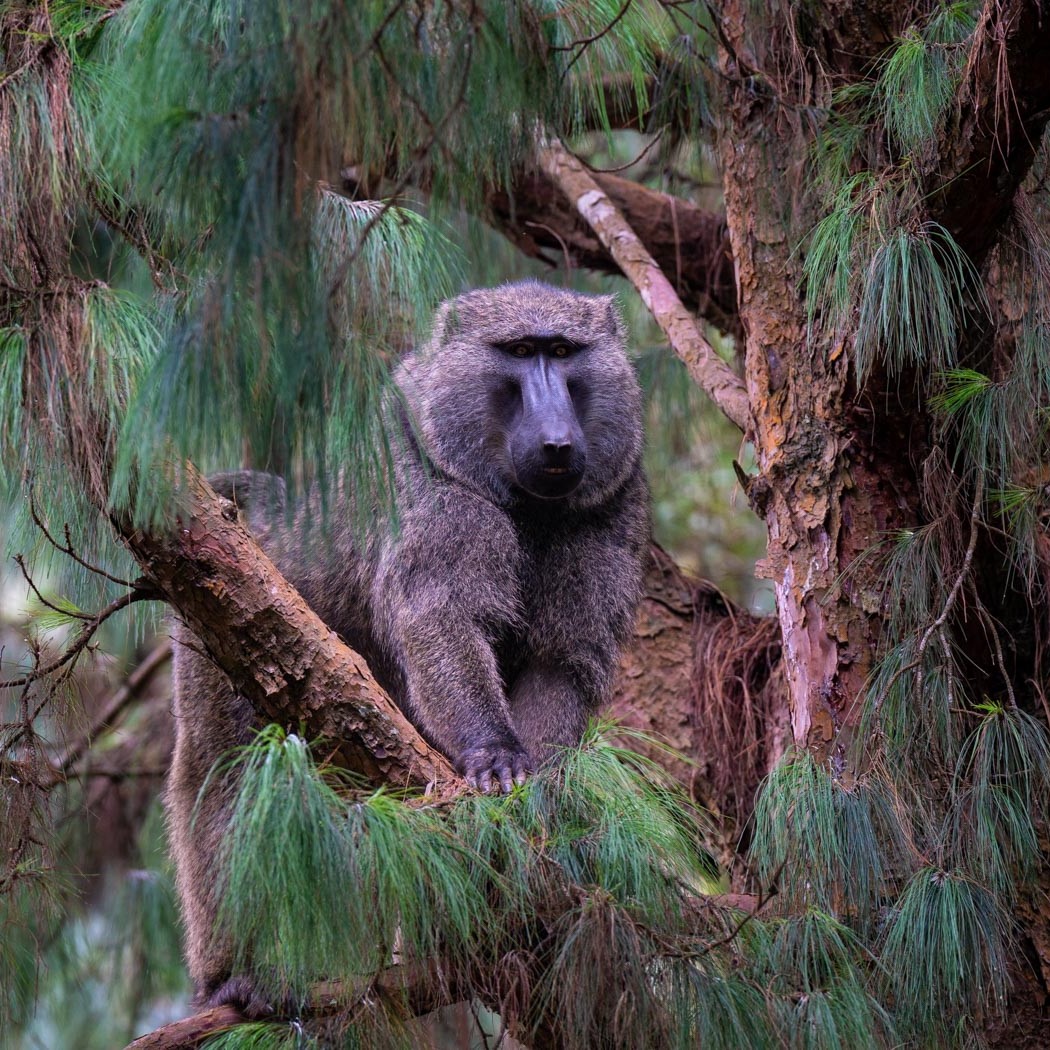
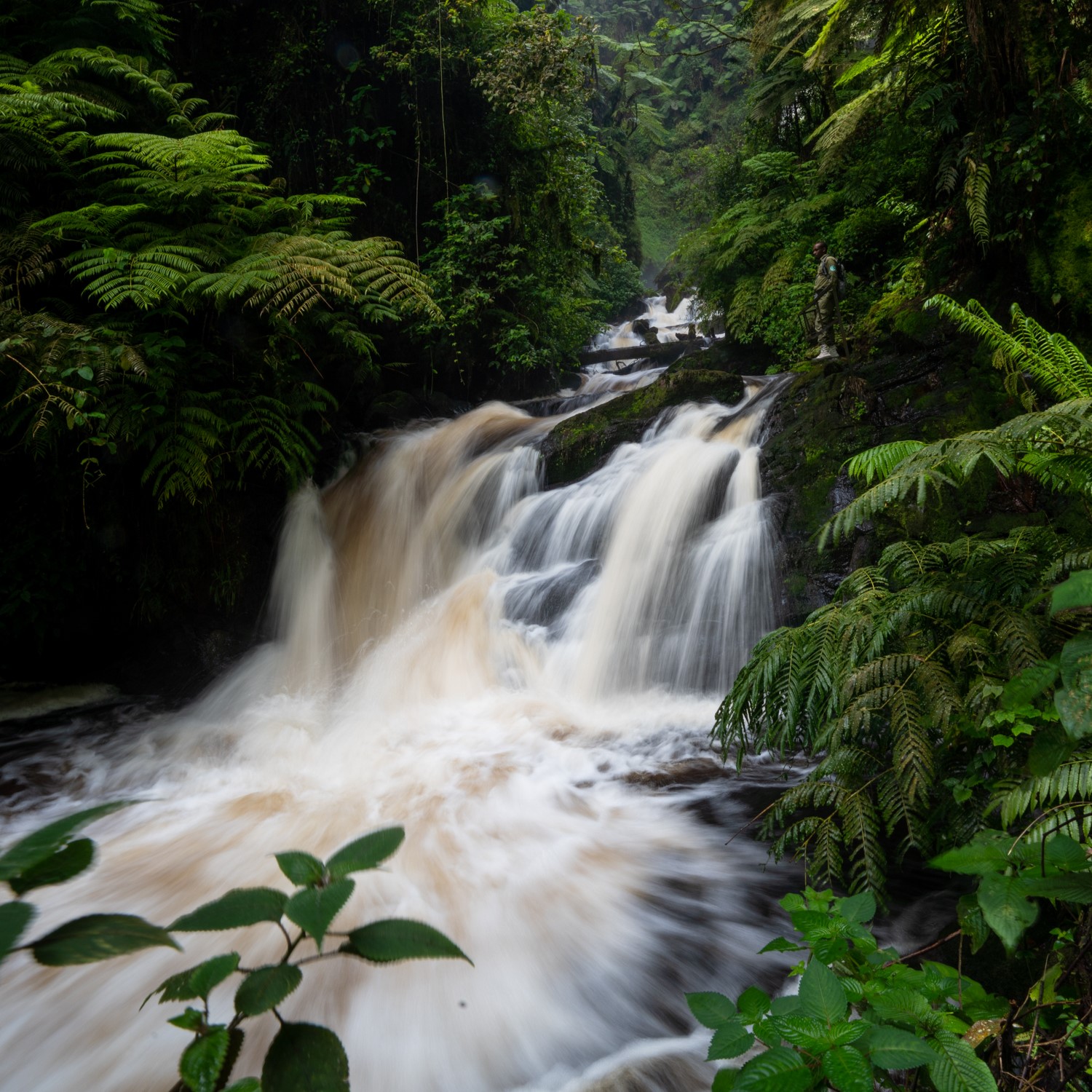
The projects that PIC supports in the rural areas of Rwanda largely focus on how people can be empowered to live in better harmony with the nature around them, reshaping how these communities utilize the natural spaces they share, and in the process, nurturing a pride in these habitats that ensures these areas’ protection in the future.
To do this, the PIC team spends 4-6 weeks traveling around Rwanda every year, meeting with these associations and getting updates on the projects. They hear what is working and what is not and help to evaluate how best the funding is utilized. But the overall key to their success – and why they have been successful where others have not – is that they listen and empower these partners to champion their own initiatives.
Many of these communities are located well off the main road, which often means the team must travel several hours over muddy, rutted roads to meet. This remoteness also contributes to why many of these communities have been overlooked.
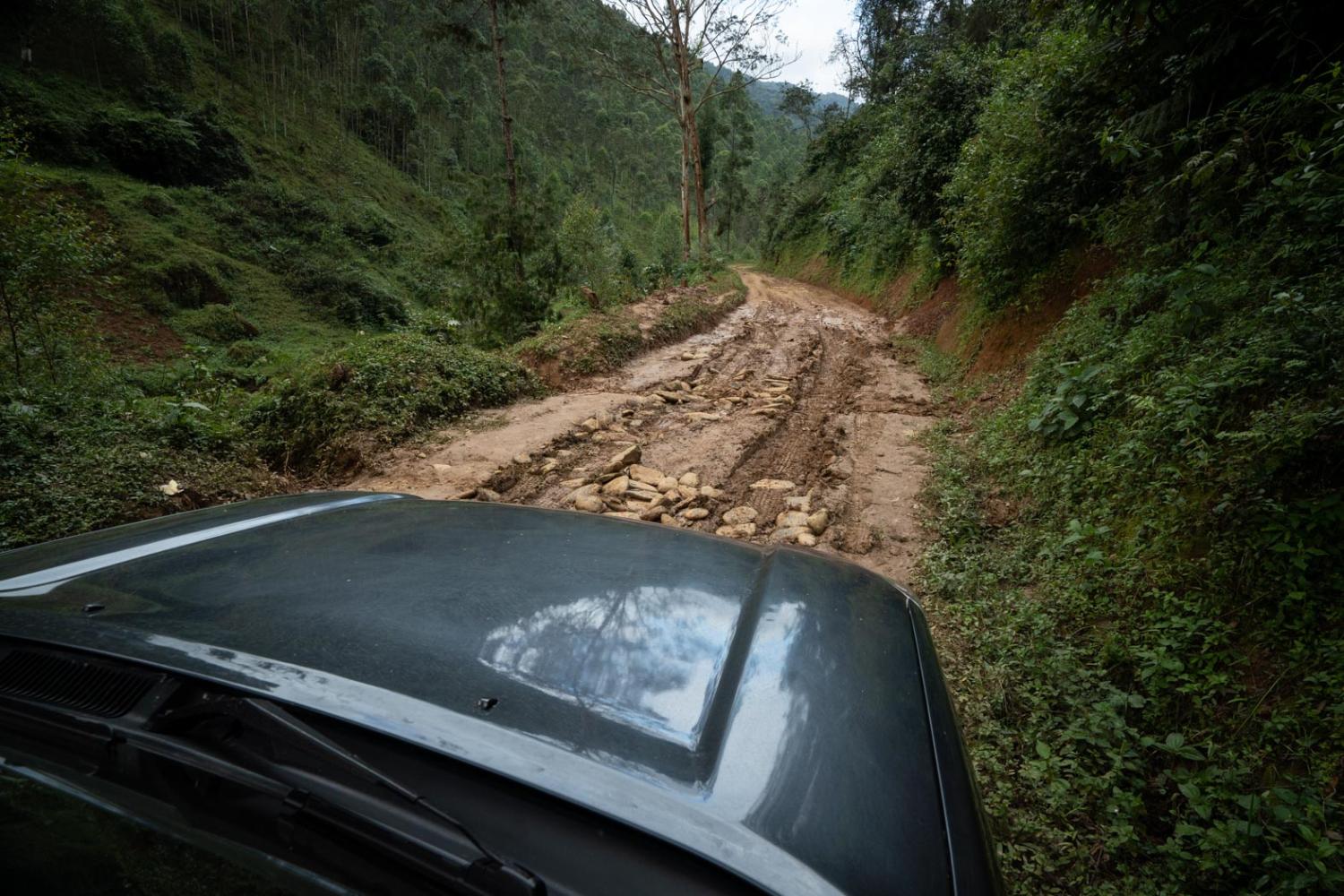
In one such village, named Banda, we visited a co-op of women who support their families by weaving intricate baskets from native grasses. Through PIC’s support, these women have been able to shift away from the forest as source for materials. Additional funding has also resulted in the construction of a workshop and storage facility for these women to utilize.
Throughout the course of the meeting, it was fascinating to watch these women discuss with the PIC team (through a translator) how the past year had been and what their thoughts were for the future, all the while their fingers moving, nimbly turning long blades of grasses into works of art. Some of these women even did so with a child on their lap or back...Multi-tasking at its finest.
In a village named Rwabidege (gwa-ba-DAY-ga), we visited a collective of ex-poachers who, among other things, have adapted to modern honey collection practices. Honey collection in Rwanda goes back hundreds of years, but the traditional methods of gathering honey from wild hives in the forests often caused uncontrolled fires, as well as opened these areas to poaching and logging. Now, using modern equipment and man-made hives positioned on the forest’s edge, only the bees go into the forest, and their keepers are able to maximize their harvest. Good for the forest, good for the beekeeper.
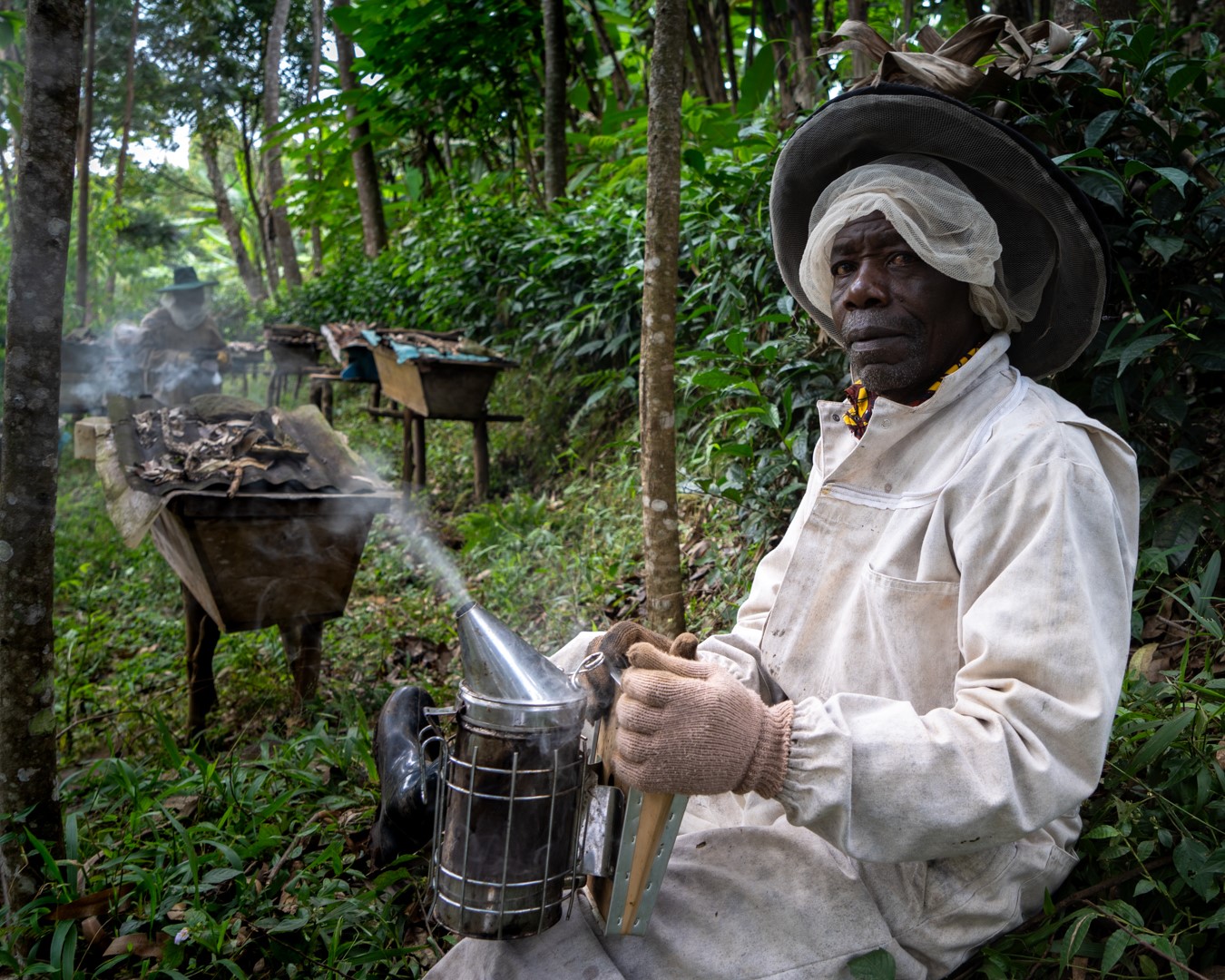
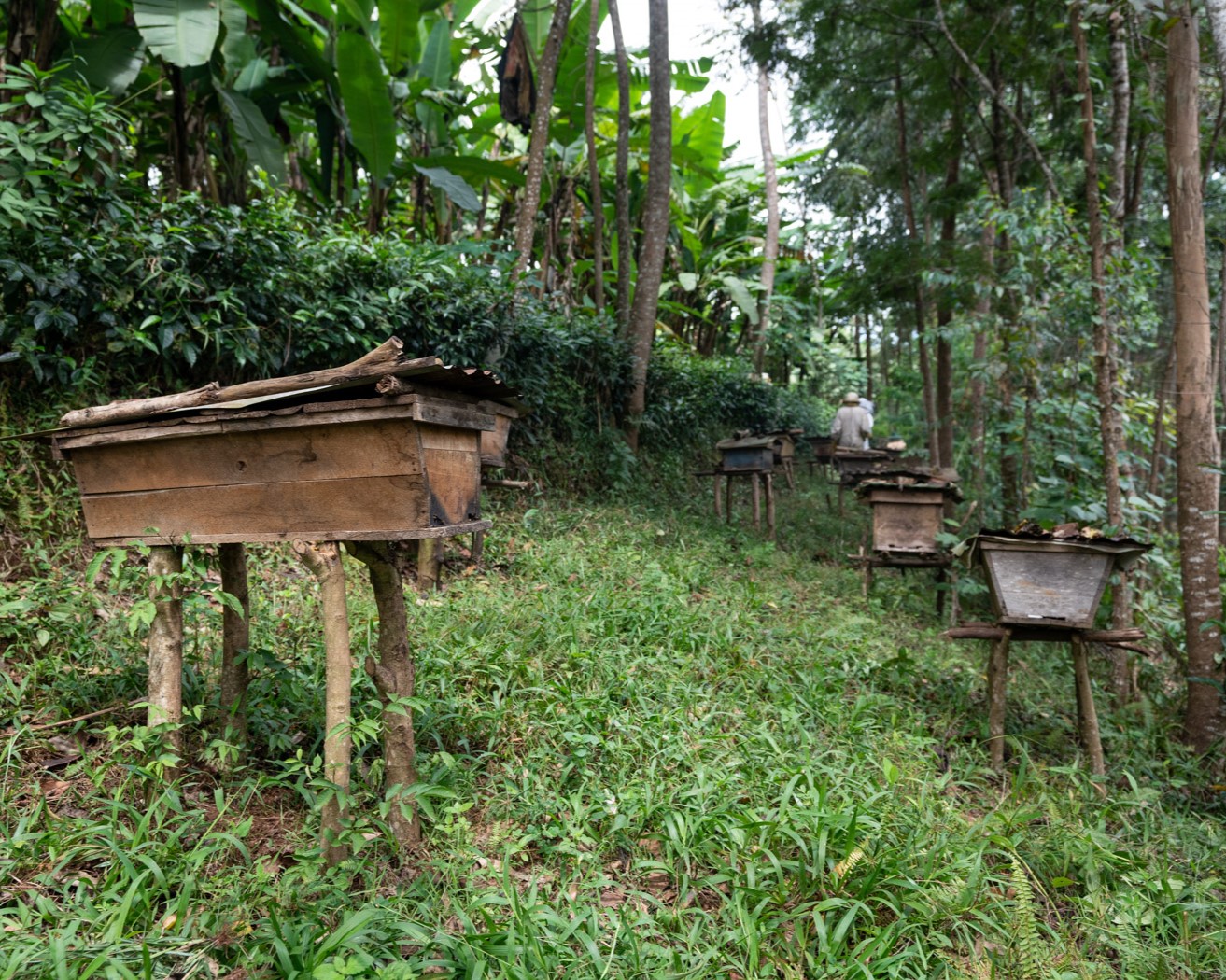
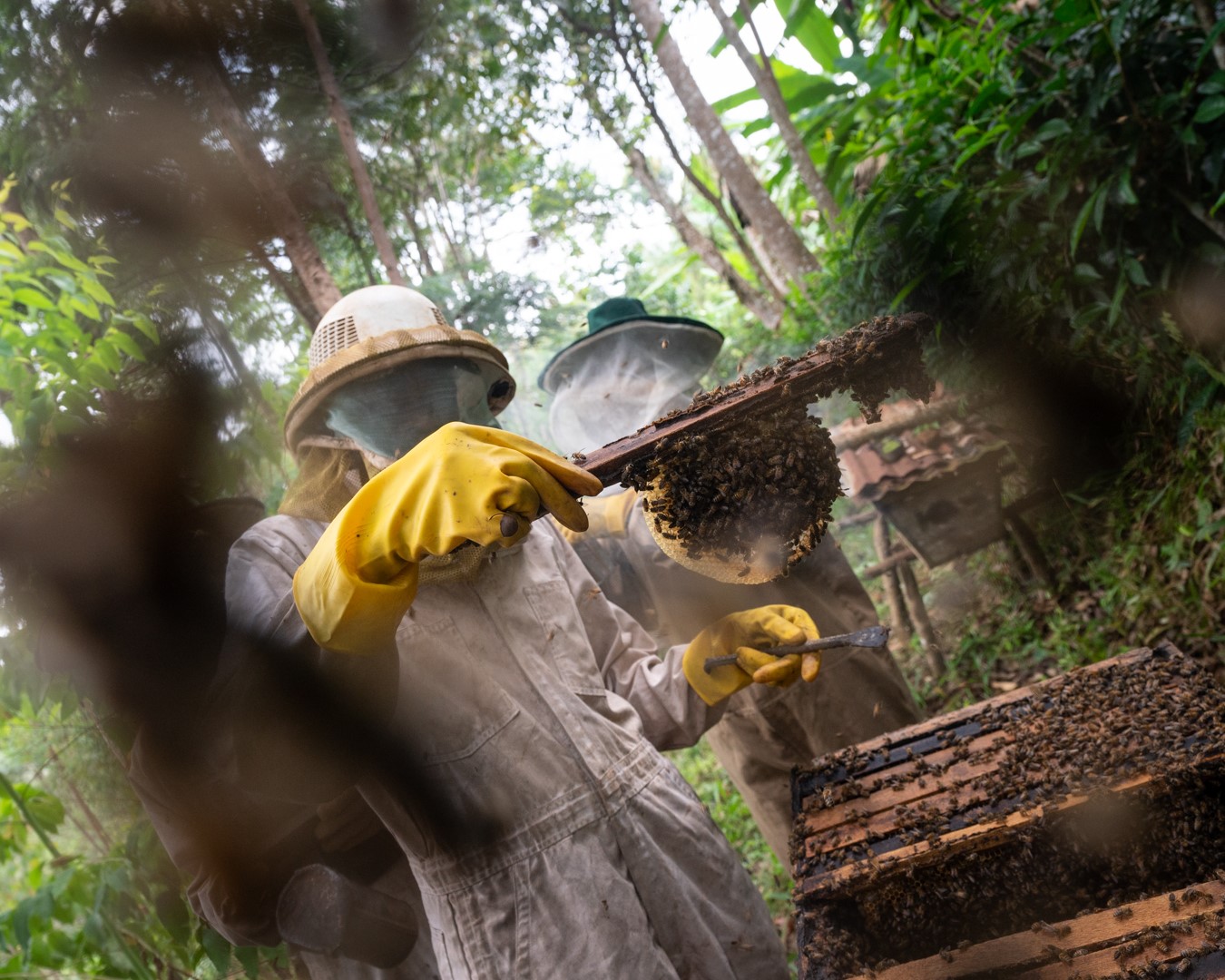
It was here that I had the opportunity to dress in a bee suit and document how these keepers tend to their “flock.” Over my years at the Columbus Zoo, I’ve gained a lot of experience working near many animals – big and small – but being in a cloud of bees so thick that they sometimes completely blocked the camera’s lens was a new one for me. The thrill of the experience turned to mild panic when, midway through, I realized that one of those bees had found its way inside my suit and was crawling up my leg.
I’m pleased to report that both the photographer and honeybee survived unscathed.
In each community we visited, I noticed that children seemed to appear from nowhere, peeking through windows or from around corners. They were curious but quick to hide when attention was directed their way, especially with a camera. I also found that, more often than not, this shyness quickly turned into a game of hide and seek and resulted in some of the biggest, most genuine smiles I’ve ever seen.
And this leads to another key element in PIC's mission: Education.
Education represents another key element to PIC’s mission, and during my time in Rwanda, we visited several schools that PIC has long supported. In addition to fundamental education, trade skills, and computer literacy, the students at these schools also learn about the importance of conserving the rich biodiversity of their country.
Our visits typically included tours of the campus, demonstrations of the lessons and skills being taught and, as I came to find out was part of almost every occasion in Rwandan culture, much singing and dancing (thankfully I discovered that hiding behind the camera gave me a pass on dancing). It was inspiring to hear that these kids were already making an impact by impressing on their elders the importance of preserving the rich biodiversity around them.
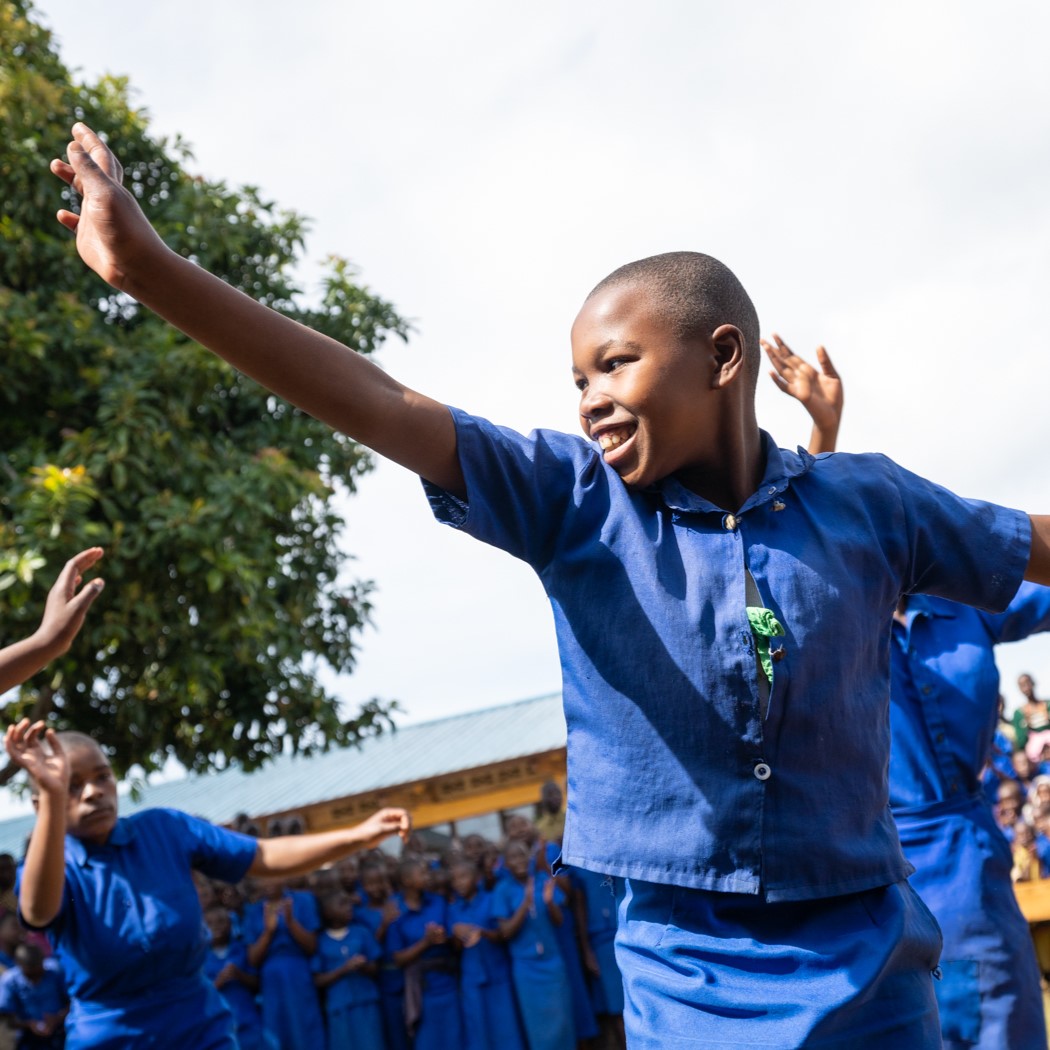
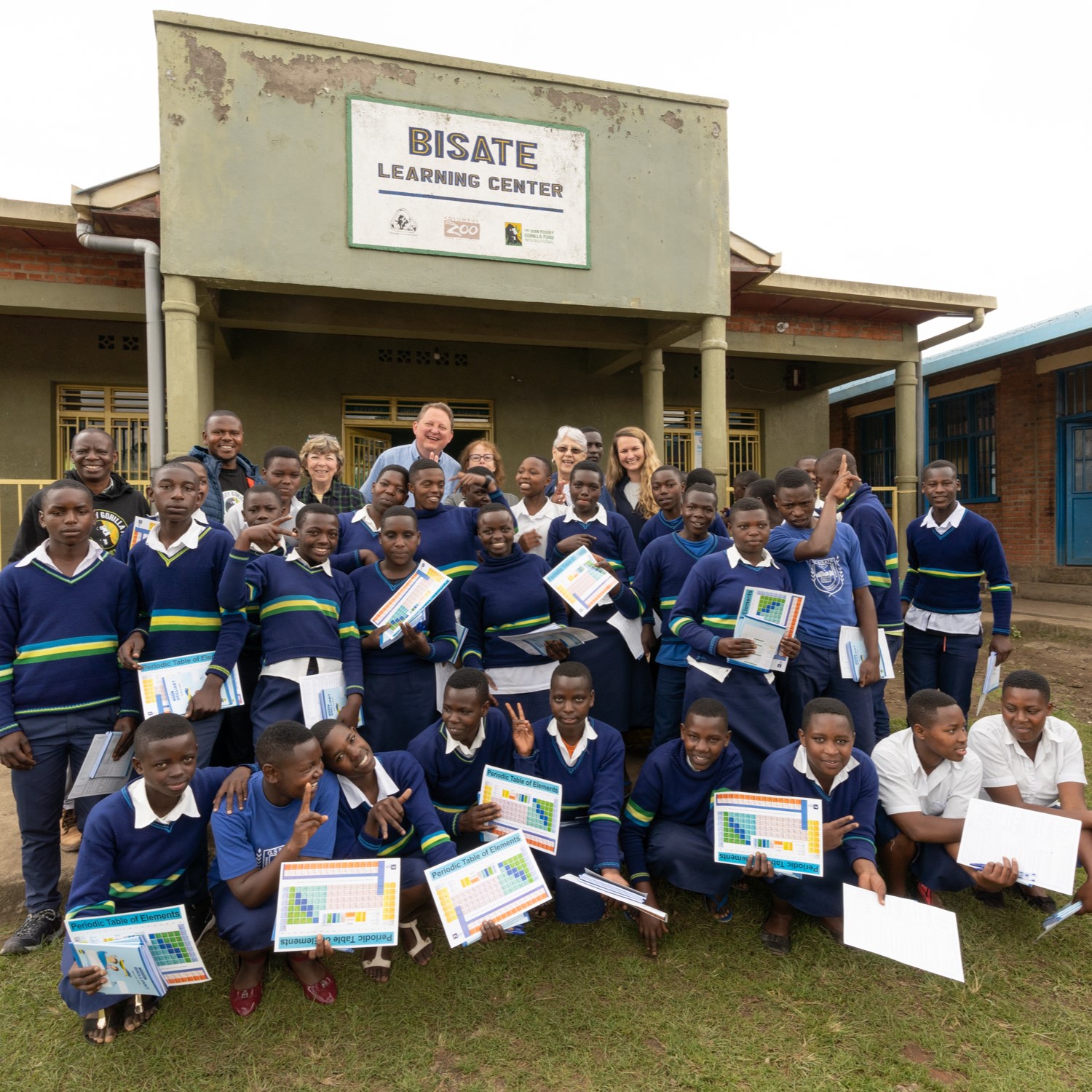
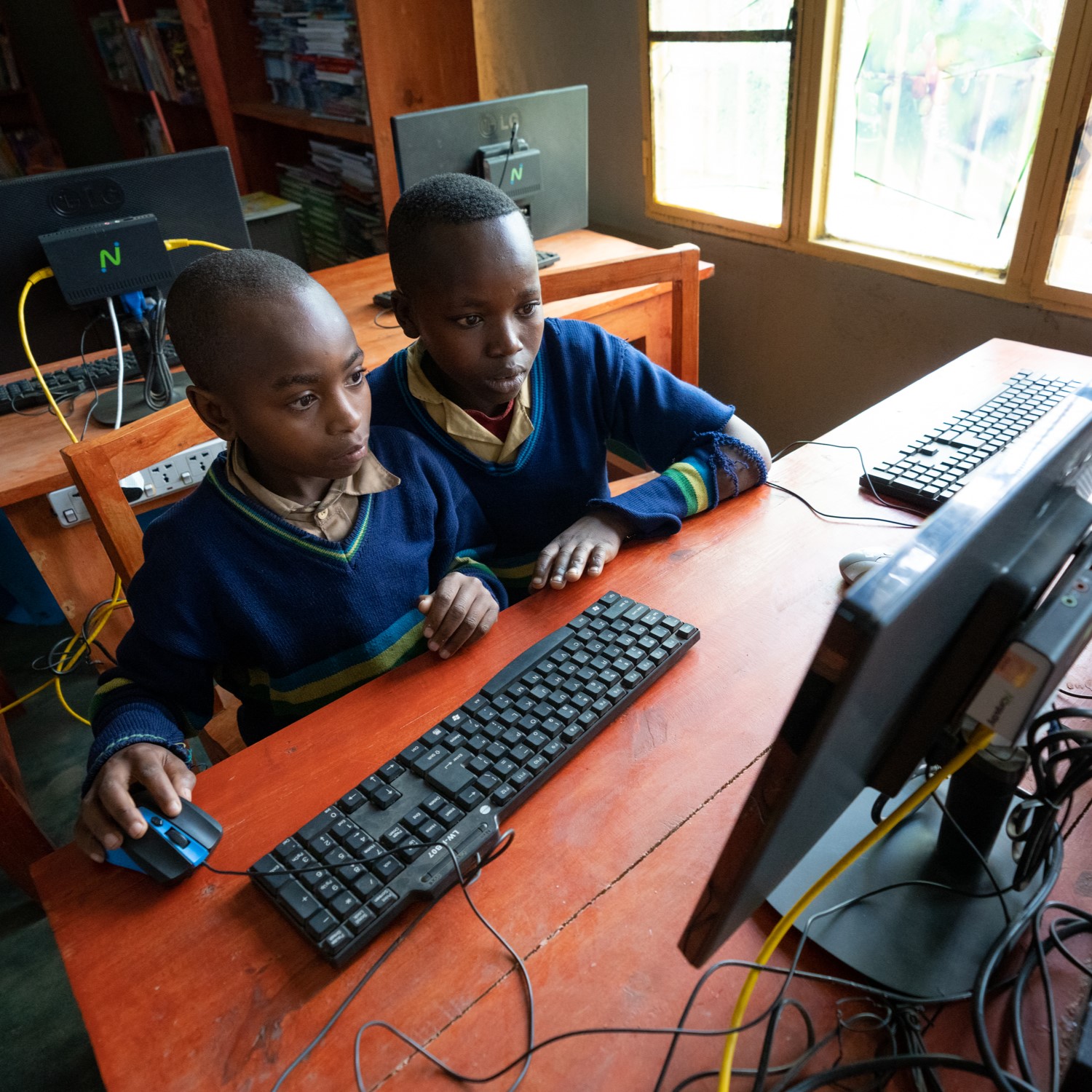
Of the many schools that PIC has longstanding ties with though, there is one that holds a particular place in my heart.
The Ubumwe Community Center (UCC) was started in 2006 by Frederick Ndabaramiye and Zacharie Dusingizimana as a safe place where people with physical and intellectual challenges could be together, receive educational and vocational training, and, most importantly, come out of the shadows of stigma. As the parent of a child with a disability, this mission, no matter where it is, matters.
What I saw at the UCC floored me.
In addition to formal subjects, I saw sign language being utilized by children (both with and without hearing), physical therapy for those with mobility challenges, occupational therapy in the form of craft making and baking classes for students with intellectual disabilities. Children were being taught to read and type braille, computer use, play musical instruments and work with textiles.
Love, acceptance, inclusion, perseverance, strength…words and photos cannot do justice to what the UCC is. The work they do, the diverse communities they serve, and the ingenuity they do it with is nothing short of amazing.
The UCC is quite simply a place that would be the pride of any community here in the U.S.
Each day in Rwanda was a flurry of meetings with craftspeople, park managers, conservationists, and educators. With each introduction, I was struck by the incredible warmth we were met with, the pride that these people have for their passions – whether it be saving a forest or simply providing for the community's needs – and the history PIC has with these organizations, many of which go back decades. Each interaction seemed more like a reunion than a business partnership and it really underlined why PIC's philosophy of listening and supporting people's needs has been so successful in making a difference.


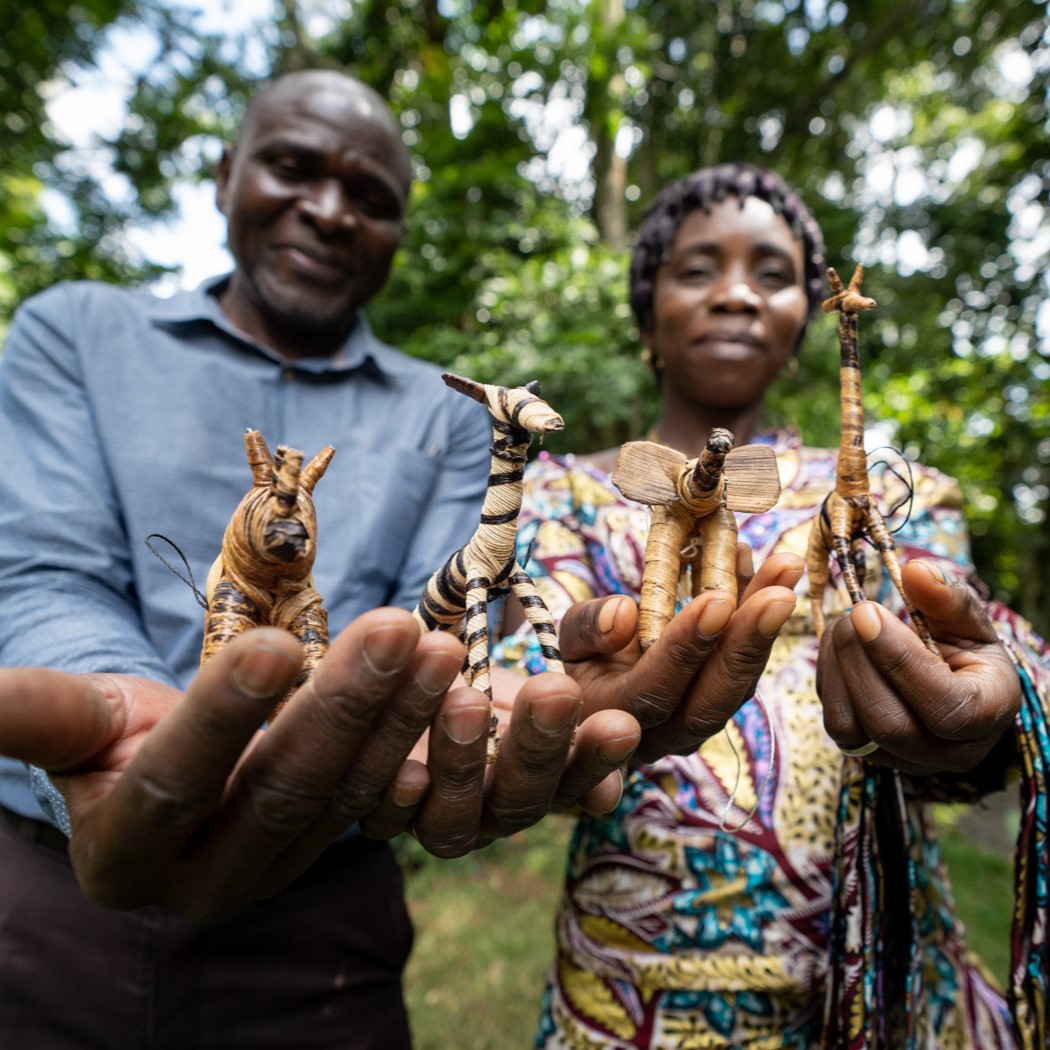
Finally, in what would be my last stop (Alison and Jeff had three more weeks of travel after my departure), we found ourselves in Musanze (Moo-san-ze), the gateway to Volcanoes National Park and the mountain gorillas’ home.
Musanze is also the headquarters of Gorilla Doctors, whose mission is to monitor and provide veterinary care to both the mountain and Grauer’s gorillas living in the national parks of Rwanda, Uganda, and the Democratic Republic of the Congo (DRC). With only a little more than an estimated 1,000 mountain gorillas and a decreasing number of Grauer’s gorillas, their work couldn’t be more important and serves as the basis for why PIC exists.
During our visit, we toured their facilities in Rwanda, learned more about their recent work, and got to see a new lab space that was in the finishing stages of construction. This space, supported in part by PIC, will help the team expand their efforts to study health trends and support researchers studying primate health.
This initiative got an exciting new boost when, in the fall of 2023, the Columbus Zoo announced plans to establish a permanent facility for the Gorilla Doctors staff who work in the Democratic Republic of the Congo (DRC). This facility will help support their life saving veterinary care to an even wider population of gorillas and will improve the efficiency and impact of the doctors that work in Virunga National Park.
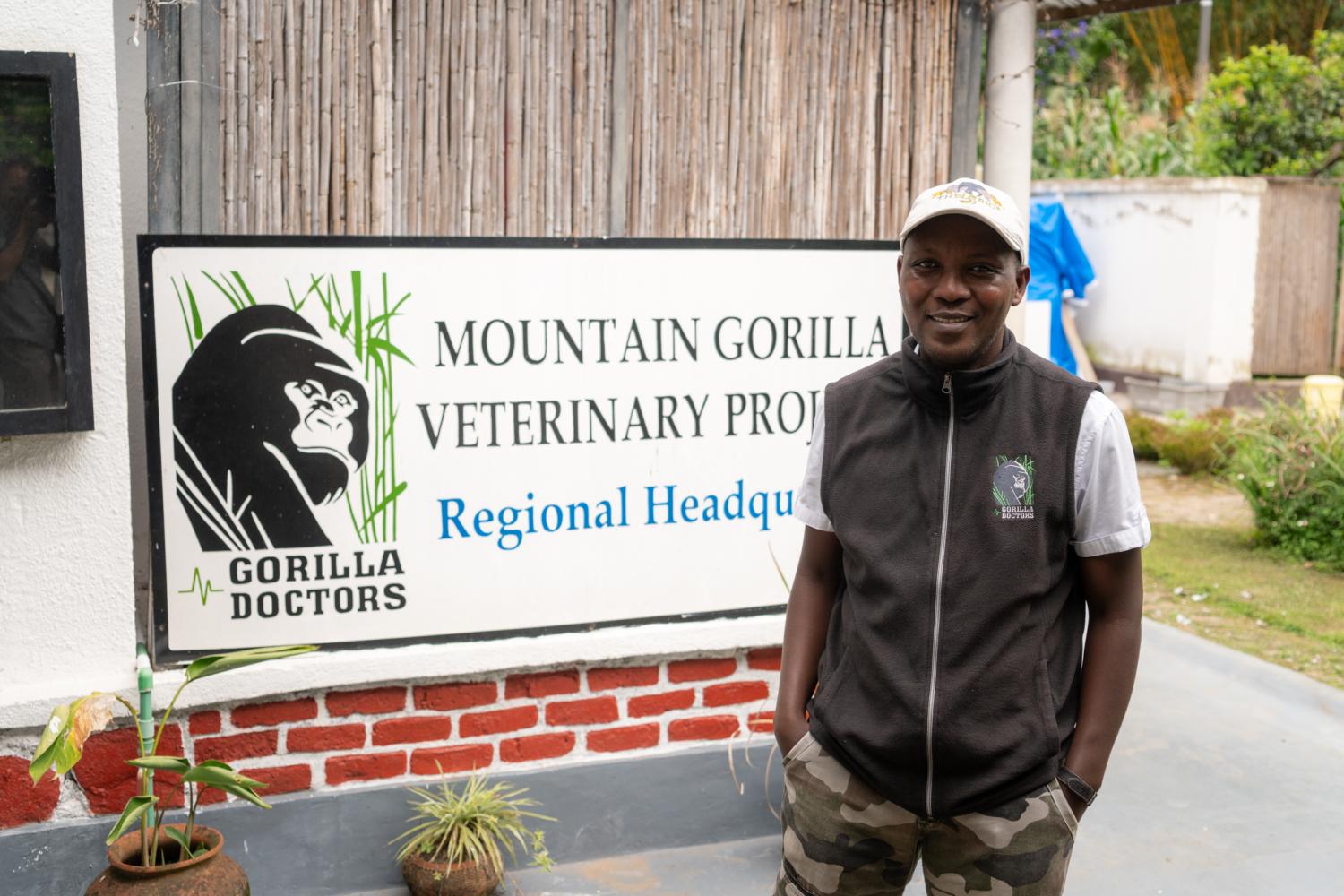
Finally, on my last full day in Rwanda, I woke early to make the trek into the mountains to see the animal that had always held so much fascination—and observe them in their own habitat. Picking up our guide at the Volcanoes National Park headquarters, we again traveled well off the main road to the base of Mount Karisimbi, a 4,500-meter dormant volcano on the Rwanda/DRC border.
From there, it was a strenuous hike, first through bamboo forests, then up through increasingly dense foliage into the clouds (turns out they’re called mountain gorillas for a reason). At times, you would step on what you thought was solid ground, only to break through a shelf of undergrowth up to your thigh. Other times, you would step into mud so deep and viscous that you weren’t sure you were going to emerge with your boots.
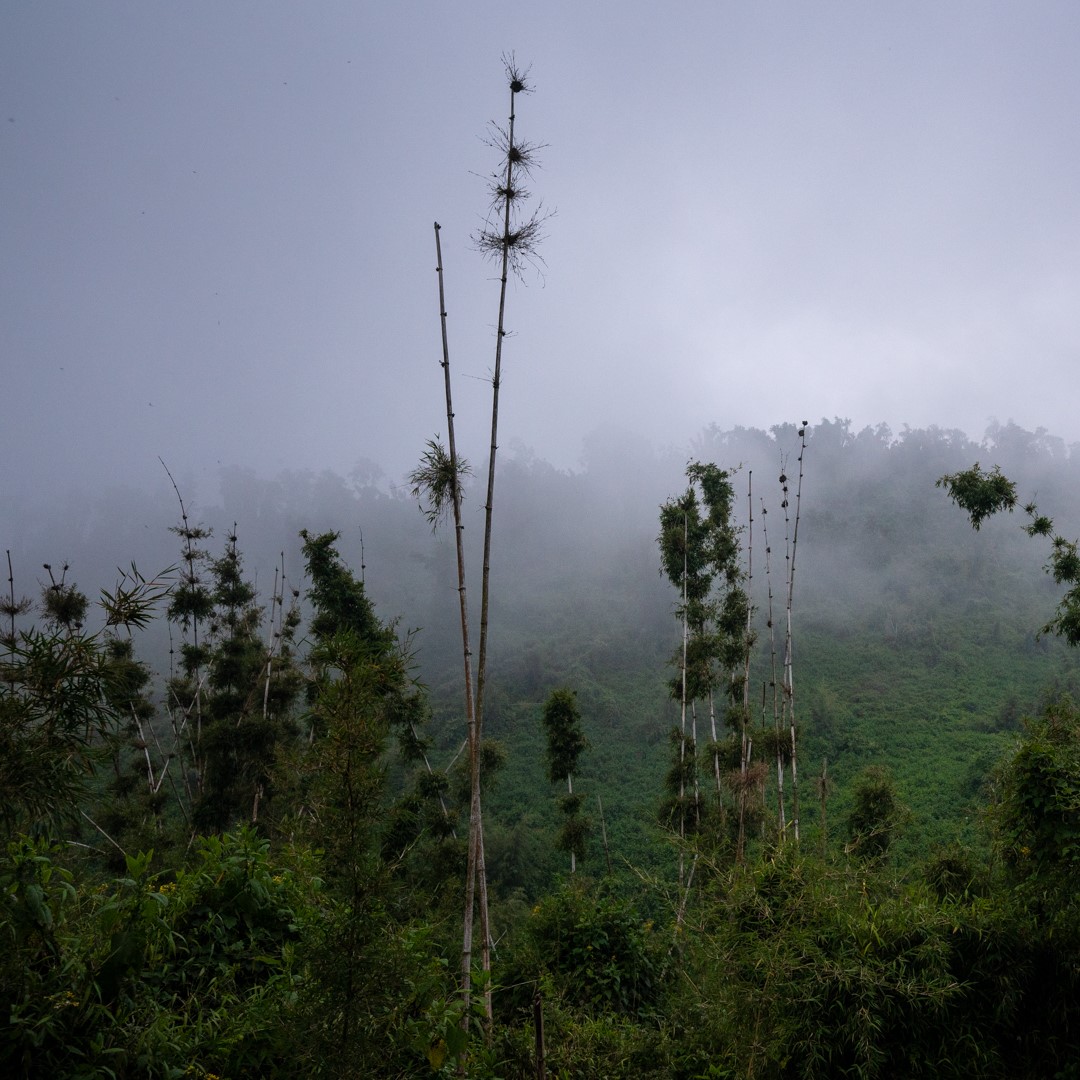
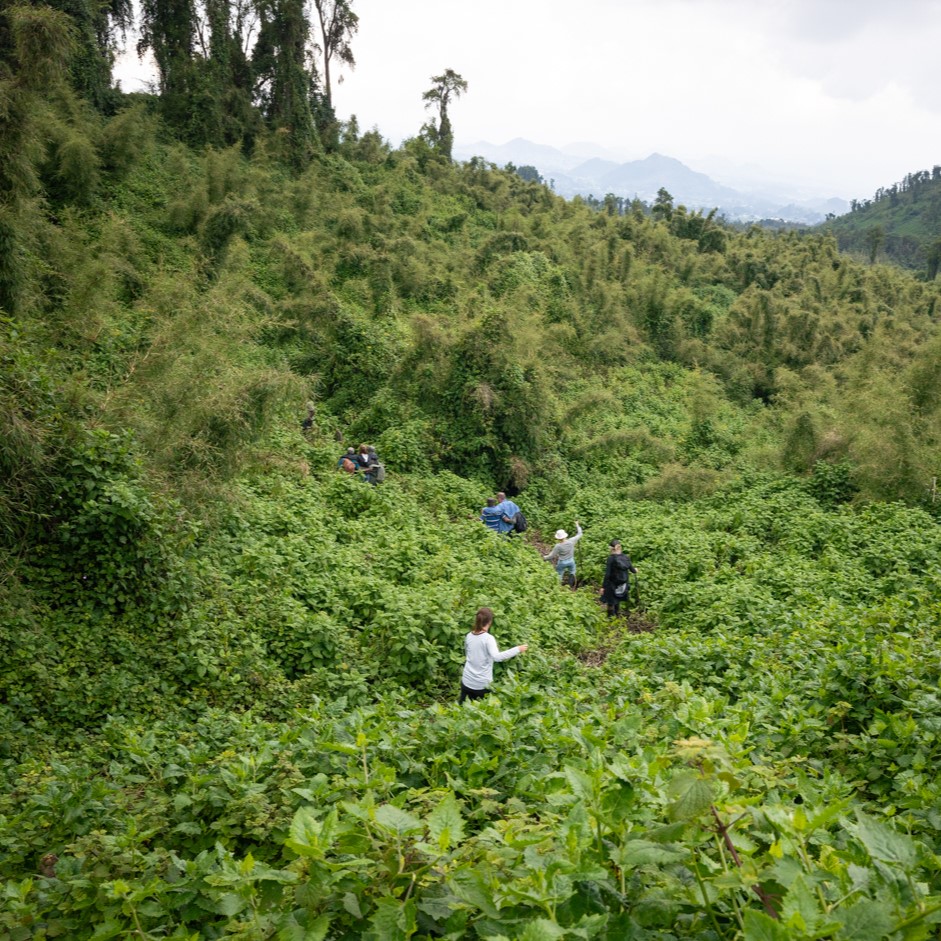
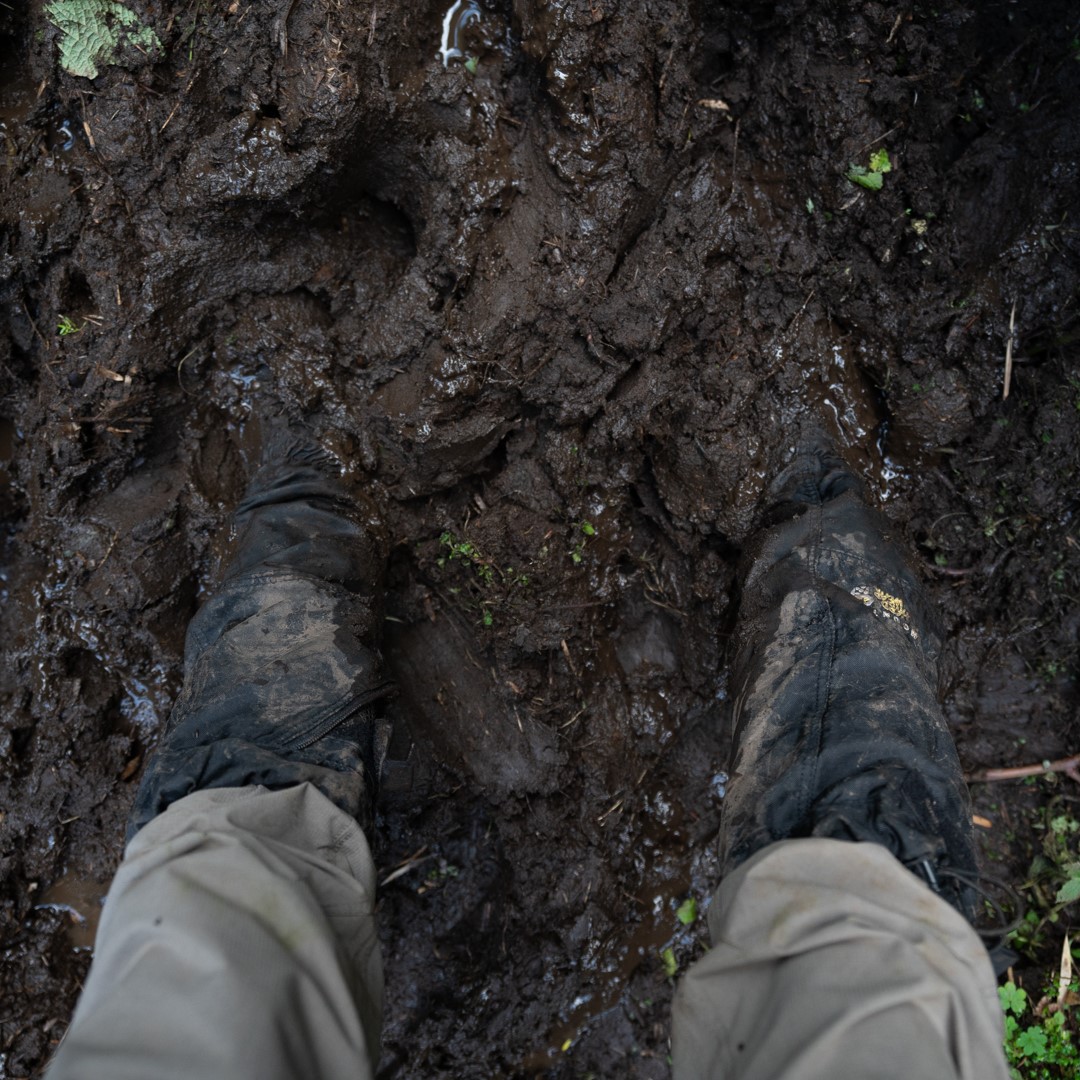
After several hours of hiking, we emerged into a steep glade, where our guides became more alert to the surrounding undergrowth. The first thing I noticed was a musky smell (might have been me) but as my gasping for air subsided, I became aware of other noises, the crunching of leaves, quiet grunts and an impressive amount of flatulence (not me). I also noticed that the foliage around us was being moved by something other than the wind.
Then, without any warning, a gorilla moved into the clearing. Then another. Then another…
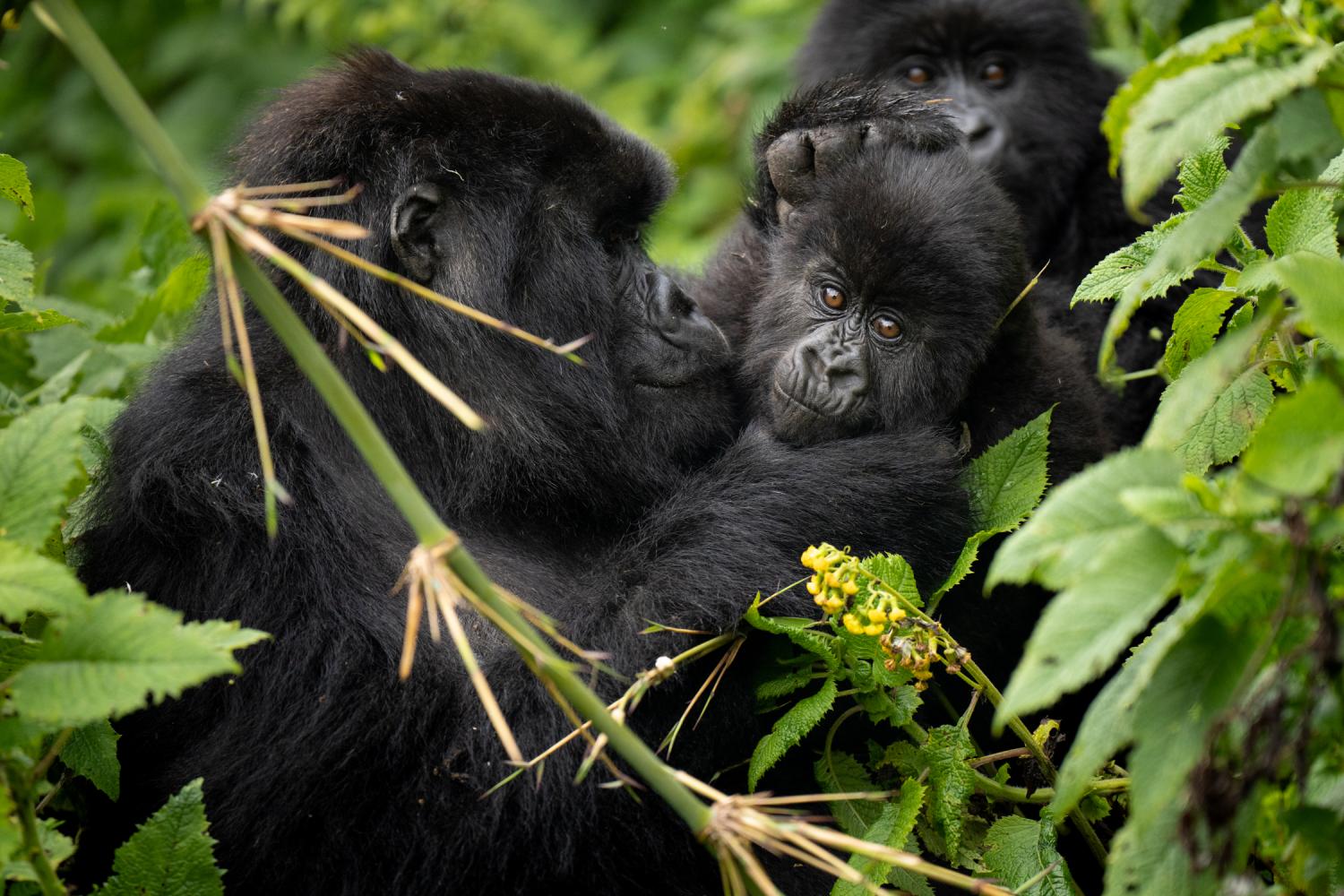
We were visiting the Igisha (E-gee-sha) group, named after the dominant silverback. At the time of our trek, there were 34 members in this group, among which included six silverbacks, 10 adult females, and 11 infants.
Despite years of experience working around gorillas at the Zoo, I had expected that being in such close proximity to these awesome animals in their home would be intimidating, but it was quite the opposite. The gorillas barely acknowledged our presence, so much so that on several occasions, we would have to step out of the way to allow one room to pass. Several times, while concentrating on taking a photo, I would feel a slight tug on my elbow from a tracker and lower the camera to find another gorilla, much closer, to my left or right.
There really are no words to describe the experience. It's transformational.

And that’s how I would describe Rwanda – the landscape, the wildlife, and especially, the people – transformational.
I saw a country that is unimaginably beautiful, strikingly poor, but rich in inspiration. Everywhere I went in Rwanda, I saw pride, resourcefulness, ingenuity, strength, hope, and potential. I saw the same hope and humor in the kids' eyes that I see in my own children and the same desires in their parents to provide the best lives for their family as I feel for mine. I saw conservationists doing amazing work against almost impossible odds and communities embracing the natural world around them.
Above all, I saw people and communities whose lives have been touched in some way – large or small – by Partners In Conservation.
As an image maker, Rwanda is without a doubt one of the highlights of my career and I can only hope that the imagery I acquired provides to our various and diverse audiences a look into the amazing work PIC does and inspires them to be a part of the global impact that the Columbus Zoo is making every day through our mission of empowering people and saving wildlife.
On a personal level though, the opportunity to become immersed in a community and culture that on the surface couldn’t be more different than my own and be reminded of just how alike we really are, and how much difference small acts can make, has been one of the highlights of my life.
